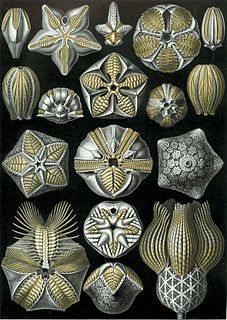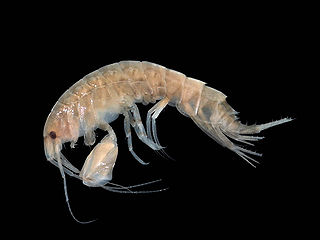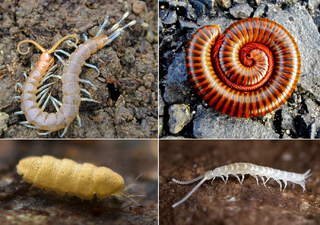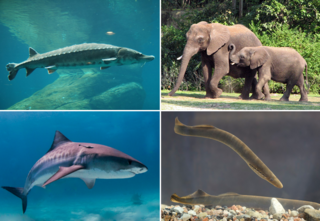 W
WAcoelomorpha is a subphylum of very simple and small soft-bodied animals with planula-like features which live in marine or brackish waters. They usually live between grains of sediment, swimming as plankton, or crawling on other organisms, such as algae and corals. With the exception of two acoel freshwater species, all known Acoelomorphs are marine.
 W
WThe Asterozoa are a subphylum in the phylum Echinodermata. Characteristics include a star-shaped body and radially divergent axes of symmetry. The subphylum includes the two classes Asteroidea, the starfish, and Ophiuroidea, the brittle stars and basket stars, and the extinct order Somasteroidea.
 W
WBlastozoa is a subphylum of extinct animals belonging to Phylum Echinodermata. This subphylum is characterized by the presence of specialized respiratory structures and brachiole plates used for feeding. This subphylum ranged from the Cambrian to the Permian.
 W
WA cephalochordate is an animal in the chordate subphylum, Cephalochordata. They are commonly called amphioxus or lancelets. They are chordates with all 5 synapomorphies, the characteristics all chordates have during the larval or adulthood stages. These synapomorphies include: notochord, dorsal hollow nerve cord, endostyle, pharynx and post-anal tail. The fine structure of the cephalochordate notochord is best known for the Bahamas lancelet, Asymmetron lucayanum Cephalochordates are represented in modern oceans by the Amphioxiformes.
 W
WThe subphylum Chelicerata constitutes one of the major subdivisions of the phylum Arthropoda. It contains the sea spiders, arachnids, and several extinct lineages, such as the eurypterids and chasmataspidids.
 W
WConchifera is a subphylum of the phylum Mollusca. It comprises all of the shell-bearing classes of molluscs, including the snails, clams, tusk shells, ammonites, monoplacophorans, and so on. The other one is Aculifera.
 W
WCrinozoa is a subphylum of mostly sessile echinoderms, of which the crinoids, or sea lilies, are the only extant members. Crinozoans have an extremely extensive fossil history, which may or may not extend into the Precambrian.
 W
WCrustaceans form a large, diverse arthropod taxon which includes such animals as crabs, lobsters, crayfish, shrimps, prawns, krill, woodlice, and barnacles. The crustacean group can be treated as a subphylum under the clade Mandibulata; because of recent molecular studies it is now well accepted that the crustacean group is paraphyletic, and comprises all animals in the clade Pancrustacea other than hexapods. Some crustaceans are more closely related to insects and other hexapods than they are to certain other crustaceans.
 W
WEchinozoa is a subphylum of free-living echinoderms in which the body is or originally was a modified globe with meridional symmetry. Echinozoans lack arms, brachioles, or other appendages, and do not at any time exhibit pinnate structure. Their two extant classes are the sea urchins and the sea cucumbers.
 W
WEleutherozoa is a proposed subphylum of echinoderms. They are mobile animals with the mouth directed towards the substrate. They usually have a madreporite, tube feet, and moveable spines of some sort, and some have Tiedemann's bodies on the ring canal. All living echinoderms except Crinoidea belong here.
 W
WThe subphylum Hexapoda constitutes the largest number of species of arthropods and includes the insects as well as three much smaller groups of wingless arthropods: Collembola, Protura, and Diplura. The Collembola are very abundant in terrestrial environments. Hexapods are named for their most distinctive feature: a consolidated thorax with three pairs of legs. Most other arthropods have more than three pairs of legs.
 W
WHomalozoa is an obsolete extinct subphylum of Paleozoic Era echinoderms, prehistoric marine invertebrates. They are also referred to as carpoids.
 W
WLinguliformea is a subphylum of inarticulate brachiopods. These were the earliest of brachiopods, ranging from the Cambrian into the Holocene. They rapidly diversified during the Cambrian into the Ordovician, but most families became extinct by the end of the Devonian.
 W
WMedusozoa is a clade in the phylum Cnidaria, and is often considered a subphylum. It includes the classes Hydrozoa, Scyphozoa, Staurozoa and Cubozoa, and possibly the parasitic Polypodiozoa. Medusozoans are distinguished by having a medusa stage in their often complex life cycle, a medusa typically being an umbrella-shaped body with stinging tentacles around the edge. With the exception of some Hydrozoa, all are called jellyfish in their free-swimming medusa phase.
 W
WMyriapoda is a subphylum of arthropods containing millipedes, centipedes, and others. The group contains over 16,000 species, most of which are terrestrial. Although their name suggests they have myriad (10,000) legs, myriapods range from having up to 750 legs to having fewer than ten legs.
 W
WRhynchonelliformea is the name now given to the articulate brachiopods, Class Articulata, revised as a subphylum. Articulate brachiopods are those with hard, articulated shells with a simple set of opening and closing muscles.
 W
WThe Sipuncula or Sipunculida is a group containing about 162 species of bilaterally symmetrical, unsegmented marine worms. The name Sipuncula is from the genus name Sipunculus, and comes from the Latin siphunculus meaning a "small tube". Sipuncula seems to be closely related to Myzostomida, and Annelida.
 W
WTrilobites are a group of extinct marine artiopodan arthropods that form the class Trilobita. Trilobites form one of the earliest-known groups of arthropods. The first appearance of trilobites in the fossil record defines the base of the Atdabanian stage of the Early Cambrian period, and they flourished throughout the lower Paleozoic before slipping into a long decline, when, during the Devonian, all trilobite orders except the Proetida died out. The last extant trilobites finally disappeared in the mass extinction at the end of the Permian about 252 million years ago. Trilobites were among the most successful of all early animals, existing in oceans for almost 300 million years.
 W
WA tunicate is a marine invertebrate animal, a member of the subphylum Tunicata. It is part of the Chordata, a phylum which includes all animals with dorsal nerve cords and notochords. The subphylum was at one time called Urochordata, and the term urochordates is still sometimes used for these animals. They are the only chordates that have lost their myomeric segmentation, with the possible exception of the 'seriation of the gill slits'.
 W
WUniramia is a group within the arthropods. In the past this group included the Onychophora, which are now considered a separate category. The group is currently used in a narrower sense.
 W
WVertebrates comprise all species of animals within the subphylum Vertebrata. Vertebrates represent the overwhelming majority of the phylum Chordata, with currently about 69,963 species described. Vertebrates include such groups as the following:jawless fishes jawed vertebrates, which include the cartilaginous fishes tetrapods, which include amphibians, reptiles, birds and mammals bony fishes
 W
WVetulicolia is the name of a taxon encompassing several extinct Cambrian organisms. The vetulicolian body comprises two parts: a voluminous anterior forebody, tipped with an anteriorly positioned mouth and lined with a row of five round to oval-shaped features on each lateral side, which have been interpreted as gills ; and a posterior section that primitively comprises seven segments and functions as a tail. All vetulicolians lack preserved appendages of any kind, having no legs, feelers or even eyes. The area where the anterior and posterior parts join is constricted.
 W
WXenoturbella is a genus of very simple bilaterians up to a few centimeters long. It contains a small number of marine benthic worm-like species.